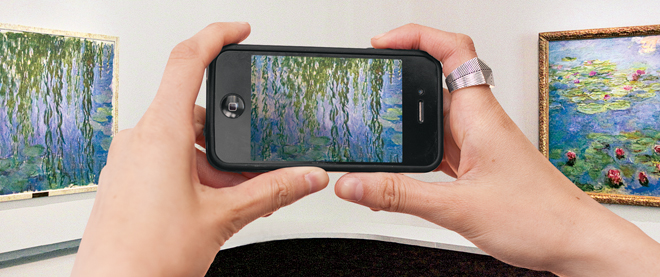Your own personal art ‘mixtape’
Big galleries may not like it, but Artfinder is revolutionizing art appreciation
Photographs by Jenna Marie Wakani, Getty Images; Photo Illustration by Bradley Reinhardt
Share

Your next trip to an art gallery may go something like this: first, you download an app onto your phone and flip through reproductions of the work you’re going to see. At the gallery, you take pictures of paintings; your phone recognizes them, and the curator’s voice in your earbuds gives you information. One work in particular captivates you, but prints aren’t available in the gift shop; no matter—you order one online. While you’re at it, you “like” the work on your social networking profile, and a link tells you there’s another gallery nearby with work by the same artist.
This is the future of art appreciation, according to Artfinder. The start-up company’s office near the British Museum in London may be in an unassuming schoolroom-like space, but its project is ambitious. With digital reproductions of over 500,000 artworks from major galleries around the globe in its database and the backing of financial giant Wellington Management and LinkedIn founder Reid Hoffman’s company Greylock Partners, it’s aiming for a revolution in the art world.
Art “hasn’t really been digitized as an experience. We’re trying to fix that,” says CEO Spencer Hyman, his long frame curved over a laptop at his office’s one table. He’s delivering a one-on-one version of the sales pitch he’s been giving galleries and museums since the company’s founding in October. Hyman seems in equal parts enthusiastic art-obsessive, tech geek and smooth salesman: exactly what you’d expect from someone whose resumé includes creating software for Amazon, digitizing board games for Hasbro Japan, and acting as COO of music social networking site Last.fm.
Hyman says he’s wanted to build something like Last.fm for the art world for years. But to realize his vision of a database and social network for art, he needed phones with apps and, crucially, cameras to become popular. Image-recognition software is the most ingenious thing about Artfinder: it can identify a painting based even on a blurry, odd-angled photo of a small part of the work. Of course, this involves actually snapping pictures of art—a practice few galleries have traditionally encouraged.
Indeed, Artfinder could force a paradigm shift. Its chair, Sherry Coutu, a transplanted British Columbian living in Cambridge, England, says galleries “may feel a bit threatened by this” because their curation “becomes easier to access for everyone.”
Xavier Bray, curator of the Dulwich Picture Gallery in south London, acknowledges that curators tend to be “quite protective of their collection.” Nonetheless, Dulwich was one of the first galleries to implement one of Artfinder’s apps, for its current Cy Twombly and Nicolas Poussin exhibition. In the fall, it will be showing paintings by Tom Thomson and the Group of Seven, and using an Artfinder app to give visitors context for what inspired the work. “You are almost asked to go out into the landscape yourself,” says Bray, “to explore Canada.”
Bray admits that as an “underdog” gallery outside of central London, Dulwich “can experiment more freely than, say, a place like the National Gallery.” Big galleries, he says, “get very nervous about collaborating with Artfinder because they believe they should be doing it on their own.”
Artfinder will get a cut of lithographs and prints that are sold with the help of its website, as well as fees from the apps it creates; eventually, it hopes to license the technology to galleries to make their own apps. Hyman compares Artfinder to digital radio, with galleries, artists and enthusiasts able to “broadcast” their favourite art to the public; he also sees a user’s personal digital collection as a “mixtape,” to be shared with friends.
The social networking aspect may also alter gallery-goers’ expectations; for instance, if a popular painting is languishing in a gallery’s storage space, users may clamour for it to be displayed. “This is where the curator will start having a conflict with the Artfinder fanatics,” laughs Bray. Not that this would be an entirely new problem: “There is a painting of bulls that I can’t stand in the gallery. I do have to sometimes succumb to public taste!”